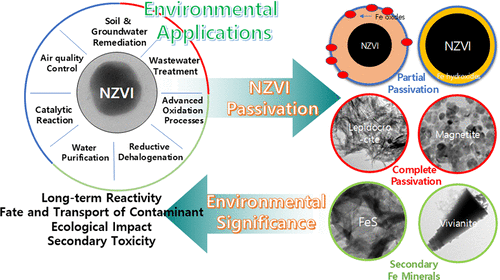当前位置:
X-MOL 学术
›
Environ. Sci. Technol.
›
论文详情
Our official English website, www.x-mol.net, welcomes your
feedback! (Note: you will need to create a separate account there.)
Advances in Surface Passivation of Nanoscale Zerovalent Iron: A Critical Review
Environmental Science & Technology ( IF 10.8 ) Pub Date : 2018-10-16 , DOI: 10.1021/acs.est.8b01734 Sungjun Bae 1 , Richard N. Collins 2 , T. David Waite 2 , Khalil Hanna 3
Environmental Science & Technology ( IF 10.8 ) Pub Date : 2018-10-16 , DOI: 10.1021/acs.est.8b01734 Sungjun Bae 1 , Richard N. Collins 2 , T. David Waite 2 , Khalil Hanna 3
Affiliation

|
Nanoscale zerovalent iron (NZVI) is one of the most extensively studied nanomaterials in the fields of wastewater treatment and remediation of soil and groundwater. However, rapid oxidative transformations of NZVI can result in reduced NZVI reactivity. Indeed, the surface passivation of NZVI is considered one of the most challenging aspects in successfully applying NZVI to contaminant degradation. The oxidation of NZVI can lead to the formation of FeII-bearing phases (e.g., FeIIO, FeII(OH)2, FeIIFeIII2O4) on the NZVI surface or complete oxidation to ferric (oxyhydr)oxides (e.g., FeIIIOOH). This corrosion phenomenon is dependent upon various factors including the composition of NZVI itself, the type and concentration of aqueous species, reaction time and oxic/anoxic environments. As such, the coexistence of different Fe oxidation states on NZVI surfaces may also, in some instances, provide a unique reactive microenvironment to promote the adsorption of contaminants and their subsequent transformation via redox reactions. Thus, an understanding of passivation chemistry, and its related mechanisms, is essential not only for effective NZVI application but also for accurately assessing the positive and negative effects of NZVI surface passivation. The aim of this review is to discuss the nature of the passivation processes that occur and the passivation byproducts that form in various environments. In particular, the review presents: (i) the strengths and limitations of state-of-the-art techniques (e.g., electron microscopies and X-ray-based spectroscopies) to identify passivation byproducts; (ii) the passivation mechanisms proposed to occur in anoxic and oxic environments; and (iii) the effects arising from synthesis procedures and the presence of inorganics/organics on the nature of the passivation byproducts that form. In addition, several depassivation strategies that may assist in increasing and/or maintaining the reactivity of NZVI are considered, thereby enhancing the effectiveness of NZVI in contaminant degradation.
中文翻译:

纳米零价铁的表面钝化研究进展:综述
纳米级零价铁(NZVI)是废水处理以及土壤和地下水修复领域中研究最广泛的纳米材料之一。但是,NZVI的快速氧化转化会导致NZVI反应性降低。实际上,NZVI的表面钝化被认为是成功将NZVI应用于污染物降解的最具挑战性的方面之一。NZVI的氧化可导致在NZVI表面形成含Fe II的相(例如Fe II O,Fe II(OH)2,Fe II Fe III 2 O 4)或完全氧化为三价铁(羟基氧化物) (例如,Fe IIIOOH)。这种腐蚀现象取决于各种因素,包括NZVI本身的组成,水性物质的类型和浓度,反应时间以及含氧/缺氧的环境。因此,在某些情况下,NZVI表面上不同的Fe氧化态的共存还可能提供独特的反应性微环境,以促进污染物的吸附及其随后通过氧化还原反应的转化。因此,对钝化化学及其相关机理的理解,不仅对有效应用NZVI至关重要,而且对于准确评估NZVI表面钝化的正负作用也至关重要。这篇综述的目的是讨论发生在各种环境中的钝化过程的性质以及形成的钝化副产物。尤其是,审查提出:(i)鉴定钝化副产物的最新技术(例如电子显微镜和基于X射线的光谱学)的优势和局限性;(ii)拟在缺氧和有氧环境中发生的钝化机制;(iii)合成程序和无机物/有机物的存在对所形成的钝化副产物的性质的影响。此外,考虑了几种可能有助于增加和/或维持NZVI反应性的钝化策略,从而提高了NZVI在污染物降解中的有效性。(ii)拟在缺氧和有氧环境中发生的钝化机制;(iii)合成程序和无机物/有机物的存在对所形成的钝化副产物的性质的影响。此外,考虑了几种可能有助于增加和/或维持NZVI反应性的钝化策略,从而提高了NZVI在污染物降解中的有效性。(ii)拟在缺氧和有氧环境中发生的钝化机制;(iii)合成程序和无机物/有机物的存在对所形成的钝化副产物的性质的影响。此外,考虑了几种可能有助于增加和/或维持NZVI反应性的钝化策略,从而提高了NZVI在污染物降解中的有效性。
更新日期:2018-10-17
中文翻译:

纳米零价铁的表面钝化研究进展:综述
纳米级零价铁(NZVI)是废水处理以及土壤和地下水修复领域中研究最广泛的纳米材料之一。但是,NZVI的快速氧化转化会导致NZVI反应性降低。实际上,NZVI的表面钝化被认为是成功将NZVI应用于污染物降解的最具挑战性的方面之一。NZVI的氧化可导致在NZVI表面形成含Fe II的相(例如Fe II O,Fe II(OH)2,Fe II Fe III 2 O 4)或完全氧化为三价铁(羟基氧化物) (例如,Fe IIIOOH)。这种腐蚀现象取决于各种因素,包括NZVI本身的组成,水性物质的类型和浓度,反应时间以及含氧/缺氧的环境。因此,在某些情况下,NZVI表面上不同的Fe氧化态的共存还可能提供独特的反应性微环境,以促进污染物的吸附及其随后通过氧化还原反应的转化。因此,对钝化化学及其相关机理的理解,不仅对有效应用NZVI至关重要,而且对于准确评估NZVI表面钝化的正负作用也至关重要。这篇综述的目的是讨论发生在各种环境中的钝化过程的性质以及形成的钝化副产物。尤其是,审查提出:(i)鉴定钝化副产物的最新技术(例如电子显微镜和基于X射线的光谱学)的优势和局限性;(ii)拟在缺氧和有氧环境中发生的钝化机制;(iii)合成程序和无机物/有机物的存在对所形成的钝化副产物的性质的影响。此外,考虑了几种可能有助于增加和/或维持NZVI反应性的钝化策略,从而提高了NZVI在污染物降解中的有效性。(ii)拟在缺氧和有氧环境中发生的钝化机制;(iii)合成程序和无机物/有机物的存在对所形成的钝化副产物的性质的影响。此外,考虑了几种可能有助于增加和/或维持NZVI反应性的钝化策略,从而提高了NZVI在污染物降解中的有效性。(ii)拟在缺氧和有氧环境中发生的钝化机制;(iii)合成程序和无机物/有机物的存在对所形成的钝化副产物的性质的影响。此外,考虑了几种可能有助于增加和/或维持NZVI反应性的钝化策略,从而提高了NZVI在污染物降解中的有效性。


















































 京公网安备 11010802027423号
京公网安备 11010802027423号